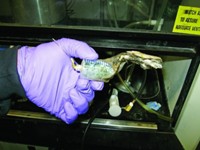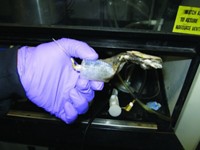Advertisement
Grab your lab coat. Let's get started
Welcome!
Welcome!
Create an account below to get 6 C&EN articles per month, receive newsletters and more - all free.
It seems this is your first time logging in online. Please enter the following information to continue.
As an ACS member you automatically get access to this site. All we need is few more details to create your reading experience.
Not you? Sign in with a different account.
Not you? Sign in with a different account.
ERROR 1
ERROR 1
ERROR 2
ERROR 2
ERROR 2
ERROR 2
ERROR 2
Password and Confirm password must match.
If you have an ACS member number, please enter it here so we can link this account to your membership. (optional)
ERROR 2
ACS values your privacy. By submitting your information, you are gaining access to C&EN and subscribing to our weekly newsletter. We use the information you provide to make your reading experience better, and we will never sell your data to third party members.
Safety
Negligence Caused UCLA Death
State safety and health agency faults university for training lapses, unsafe practices
by Jyllian N. Kemsley
May 11, 2009
| A version of this story appeared in
Volume 87, Issue 19
Negligence of lab safety by the department of chemistry and biochemistry at the University of California, Los Angeles, led to the Dec. 29, 2008, accident and subsequent death of researcher Sheharbano (Sheri) Sangji, says the state agency charged with investigating the incident.
In particular, the California Division of Occupational Safety & Health (Cal/OSHA) cited the department in a report released on May 4 for lacking both safety training and training documentation; failing to ensure employees wore appropriate personal protective equipment (PPE), such as lab coats; and failing to correct unsafe conditions and work practices identified in an Oct. 30, 2008, laboratory safety inspection.
Among the findings of the October lab inspection was that PPE was not fully used in the lab in which the 23-year-old Sangji worked. She was not wearing a lab coat in December when pyrophoric material she was handling splashed and ignited her clothing.
Sangji's supervisor, professor Patrick Harran, says that he did address the PPE issues with his group. "My expectation is that everyone is to wear a lab coat and wear protective gear on their eyes," he says, adding that a lab coat is specifically ordered for everyone who joins the group. He refused to speculate as to why Sangji was not wearing her coat on the day of the accident. The two postdoctoral researchers who were in the lab with her were both wearing their lab coats, Harran says.
In a prepared statement, UCLA says that other issues identified in the October inspection had been corrected, but the improvements had not been documented because Harran's group was moving to new lab space. Safety officers planned to reinspect the lab after it had relocated, the university says.
The Cal/OSHA report says that, when the incident occurred, Sangji was drawing approximately 20 mL of 1.7 mol/L tert-butyllithium in pentane into a 60-mL syringe when the syringe plunger was either ejected or pulled out of the syringe. An undetermined amount of the liquid splashed onto her hands, arms, and torso. The ensuing fire burned more than 40% of her body. One of the postdoctoral researchers used his lab coat to extinguish the flames and called for help. Sangji died of her injuries on Jan. 16 (C&EN Online Latest News, Jan. 22).
The Cal/OSHA report "sheds very little light on the incident," says Naveen Sangji, Sheri's sister. Naveen and her family would still like to know more about the circumstances that led to the fire.
The Cal/OSHA citations carry a total fine of $31,875. It is the largest fine levied by the agency in seven investigations since 2006 that involved academic research labs or the chemical or biotechnology industry. In incidents that involve a fatality, Cal/OSHA routinely forwards its findings to the local district attorney's office to evaluate whether criminal prosecution is warranted.
"I think Cal/OSHA did everything they could" within their regulatory structure to penalize UCLA, says Neal Langerman, the founder of the company Advanced Chemical Safety and a consultant to the American Chemical Society Committee on Chemical Safety.
UCLA will not contest the findings or appeal the fine, it says in its statement. The university also outlined the steps it is taking to address the deficiencies, including requiring written safety assessments of laboratory procedures. The assessments include quantifying hazards, assessing potential risks, and specifying appropriate PPE. The university is also developing new standard operating procedures for handling high-risk materials, it says.
Sangji graduated in May 2008 with a bachelor's degree in chemistry from Pomona College. She then worked at Norac Pharma, in Azusa, Calif., for four months before starting work in Harran's lab.
Regarding Sangji's training to handle tert-butyllithium, "She was supervised by senior personnel in my lab and shown how to do this particular procedure. She repeated it successfully," Harran says. Nevertheless, he says that in hindsight he overestimated "her understanding of the care necessary when working with such materials."
Langerman says the safety culture in academia generally lags far behind that in industry and that even minor incidents in academic labs are far too frequent and treated as too routine. He adds that the incident that led to Sangji's death could happen at any school and should serve as a wake-up call for faculty, university officials, funding agencies, and professional societies to put a new emphasis on lab safety.







Join the conversation
Contact the reporter
Submit a Letter to the Editor for publication
Engage with us on Twitter